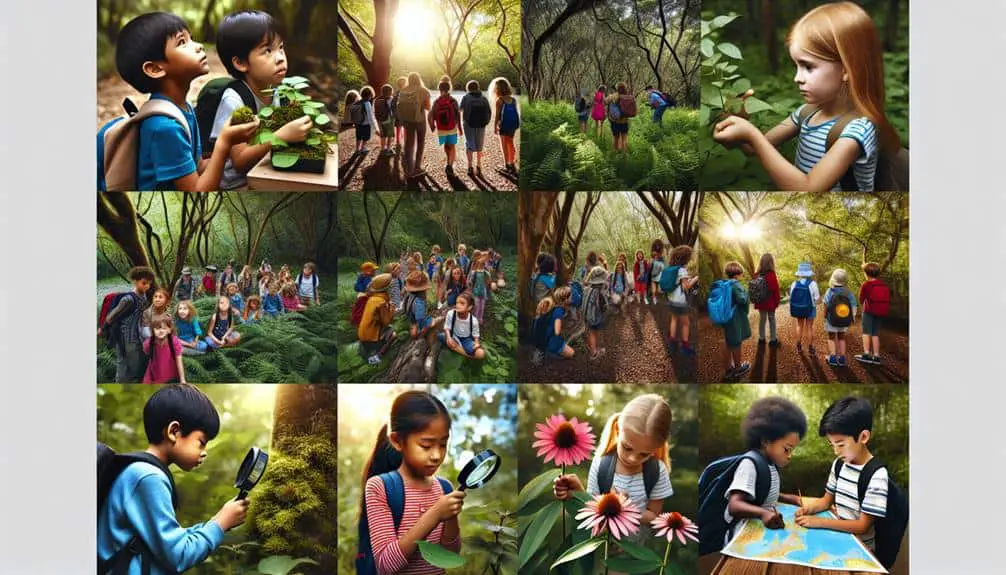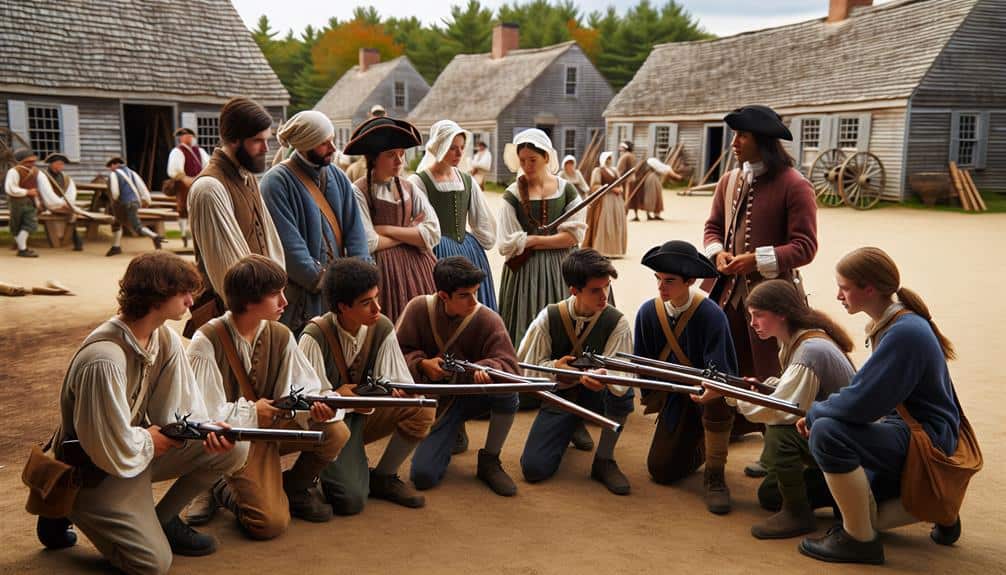Embark on a wild homeschool field trip with photography tips perfect for capturing nature's essence. Pack your sturdy backpack, utilize gear wisely, and safeguard your camera in padded compartments. Play with settings, master manual mode, and discover visual appeal in shooting locations. Guide the eye with leading lines, frame for depth, and use the Rule of Thirds for balance. Let natural light shine through, experiment in the golden hour, and play with shadows for drama. Perfect your shots by understanding wildlife behavior, choosing the right gear, and adjusting camera settings. Discover more photography secrets for your next adventure.
Key Points
- Understand wildlife behavior for better shots.
- Use natural lighting to enhance images.
- Choose appropriate gear, like a telephoto lens.
- Adjust camera settings for wildlife behavior.
- Utilize composition techniques for impactful photos.
Essential Gear for Wilderness Photography
When venturing into the wilderness for photography, a sturdy backpack is vital to carry your gear comfortably and securely. The weight distribution of the backpack plays an important role in guaranteeing your equipment remains safe during your adventures. Make sure the backpack has padded compartments to safeguard your camera and lenses from any bumps or jolts along the way.
Camera settings are key in capturing the perfect shot in the wild. Adjusting your aperture, shutter speed, and ISO settings can make a significant difference in the outcome of your photographs. It's crucial to familiarize yourself with your camera's manual mode to have full control over these settings and unleash your creativity.
Tripod stability is essential to achieving sharp, clear images, especially in low light conditions or when using slower shutter speeds. Invest in a sturdy tripod that can support the weight of your camera and lens without any wobbling. Make sure the tripod is set up on solid ground to prevent any unwanted vibrations that could result in blurry photos.
Choosing the Right Shooting Location
To capture stunning wilderness photographs, selecting the right shooting location is key to composing visually engaging and impactful images. When scouting locations, consider the natural backdrops available. Look for settings that offer interesting textures, colors, and shapes to enhance your subject.
Remote spots often provide unique opportunities for capturing untouched beauty, while popular areas may offer iconic landmarks or wildlife sightings.
In choosing between remote and popular spots, consider the level of solitude you desire versus the potential for crowds. Remote locations can offer a sense of tranquility and exclusivity, allowing you to focus on capturing the essence of nature without distractions. On the other hand, popular spots may provide easier access and well-known vistas that can still result in stunning images if captured creatively.
Don't forget to take into account lighting considerations when selecting a shooting location. The quality of light can greatly impact the mood and atmosphere of your photographs. Choose times of day when the light is soft and warm, such as during the golden hours at sunrise or sunset, to add a magical touch to your images.
Composing Captivating Nature Shots
Consider incorporating leading lines, framing elements, and the rule of thirds to compose enchanting nature shots that draw viewers' eyes into the scene with visual interest and balance.
When capturing the beauty of nature through your lens, these composition tips can greatly enhance the impact of your photographs:
- Leading Lines: Utilize natural elements like rivers, paths, or branches to lead the viewer's gaze into the focal point of your image, creating a sense of depth and guiding their eyes through the scene.
- Framing Elements: Incorporate natural frames such as overhanging branches, doorways formed by trees, or even rock formations to add depth and context to your composition, drawing attention to the main subject.
- Rule of Thirds: Divide your frame into a 3×3 grid and position key elements of your photo along these lines or at their intersections. This technique creates a visually appealing composition that's well-balanced and engaging to the viewer.
Lighting Techniques in the Wild
Enhance the allure of your wild photography by mastering lighting techniques that accentuate the natural beauty of your surroundings. When capturing the wild, understanding how natural light interacts with your subjects is essential. Utilize the soft, diffused light of early mornings or late afternoons known as the 'golden hour' to add warmth and depth to your images.
During this time, shadows are longer, creating texture and dimension in your photos. Experiment with backlighting to create stunning silhouettes or emphasize the delicate details of flora and fauna.
Pay attention to how light filters through the trees or reflects off bodies of water, enhancing the magic of the wild. Shadows can add drama and mystery to your compositions, drawing the viewer's eye to specific focal points. Incorporating natural light effectively can transform an ordinary scene into a mesmerizing work of art.
Capturing Wildlife in Homeschool Field Trips
When capturing wildlife during your homeschool field trips, remember the basics of wildlife photography. Choose the right gear, such as a telephoto lens, to get those up-close shots.
Utilize these tips to make sure you come back with great wildlife shots that capture the essence of your field trip experience.
Wildlife Photography Basics
To capture stunning wildlife photographs during your homeschool field trips, focus on understanding animal behavior and utilizing natural lighting for best results.
When delving into the world of wildlife photography, consider the following:
- Camera Settings and Wildlife Behavior: Adjust your camera settings to suit the specific wildlife you're photographing. Different animals may require different approaches, such as fast shutter speeds for birds in flight or a wider aperture for close-up shots of insects.
- Natural Habitats and Photography Techniques: Study the natural habitats of the wildlife you intend to photograph. Understanding where and when to find them can greatly increase your chances of capturing compelling images. Additionally, experiment with various photography techniques such as framing, leading lines, and the rule of thirds to add depth and interest to your shots.
- Lighting and Composition: Take advantage of natural lighting to enhance the beauty of your wildlife subjects. Early morning or late afternoon light can create a warm, soft glow that elevates your images. Pay attention to composition by carefully framing your shots and focusing on the eyes of the animals for a more engaging photo.
Choosing the Right Gear
Understanding the specific gear requirements for capturing wildlife during your homeschool field trips is key to achieving high-quality photographs. When it comes to lens selection, opt for a telephoto lens with a long focal length to capture distant animals without disturbing them.
Consider camera settings like a fast shutter speed to freeze animal movements and a wide aperture for a blurred background that makes your subject stand out.
Using a tripod is crucial for stability, especially when using longer lenses that can be heavy. This helps avoid camera shake and ensures sharp images.
Additionally, consider filter options like a polarizing filter to reduce glare and enhance colors, or a UV filter for lens protection in outdoor environments.
Tips for Great Shots
Consider these essential photography tips for capturing wildlife during your homeschool field trips with precision and artistry.
- Master Framing Techniques:
When photographing wildlife, pay attention to the framing of your shots. Use natural elements like branches or leaves to frame the subject, creating a more dynamic and visually appealing composition.
- Adjust Exposure Settings:
Wildlife photography often involves varying light conditions. Experiment with exposure settings to make sure your subject is well-lit without overexposure. Consider using spot metering to focus on the animal and adjust exposure accordingly.
- Capture Action Shots and Candid Moments:
Wildlife is full of movement and unexpected behaviors. Be ready to capture action shots by using a fast shutter speed to freeze motion. Additionally, keep your camera handy to capture candid moments that showcase the natural behavior and beauty of the animals you encounter.
Editing Tips for Stunning Field Trip Photos
Enhance your field trip photos with expert editing techniques that will elevate the visual appeal of your captures. Start by applying color correction to make sure your images reflect the true hues of the scene. Adjust brightness, contrast, and saturation to achieve a more vibrant and lifelike representation.
Experiment with cropping techniques to focus on the main subject and remove distracting elements from the frame. By cropping strategically, you can improve the composition and draw the viewer's eye to the key elements in your photo.
Next, consider using filters and effects to add a creative touch to your field trip photos. Experiment with different filters to create unique moods or enhance specific features of your images. Effects like vignettes, blurs, and textures can also be applied tastefully to add depth and visual interest to your captures.
Remember to use these tools subtly to enhance your photos without overpowering the natural beauty of the scene. With these editing tips, you can transform your field trip photos into stunning visual stories that capture the essence of your adventures.
Frequently Asked Questions
How Can I Ensure My Camera Gear Stays Safe During Outdoor Field Trips?
To keep your camera gear safe during outdoor adventures, invest in sturdy cases and bags designed for nature excursions. Use lens caps, camera straps, and weatherproof covers for extra protection. Prioritize gear safety to capture stunning moments worry-free.
Are There Any Specific Etiquette Rules for Photographing Wildlife During Field Trips?
When photographing wildlife during field trips, practice respectful behavior towards the animals by maintaining a safe distance and not disturbing their natural habitat. Consider privacy concerns and avoid intruding on their space for the best shots.
What Are the Best Ways to Capture Candid Moments During Homeschool Field Trips?
To capture candid moments during homeschool field trips, focus on natural lighting for authentic tones. Encourage candid poses by engaging with subjects. Use framing and composition techniques to create visually compelling images that tell a story.
How Can I Involve My Children in Photography During Field Trips?
To involve your children in photography during field trips, encourage them to explore creative activities like framing unique shots or capturing details. Make it educational fun by teaching them about composition and lighting on the go.
Are There Any Legal Considerations When Photographing Nature on Field Trips?
When photographing nature on field trips, remember privacy concerns and property rights. Respect others' boundaries and obtain permission when needed. Be mindful of capturing images ethically and legally to create meaningful and respectful photographs.



